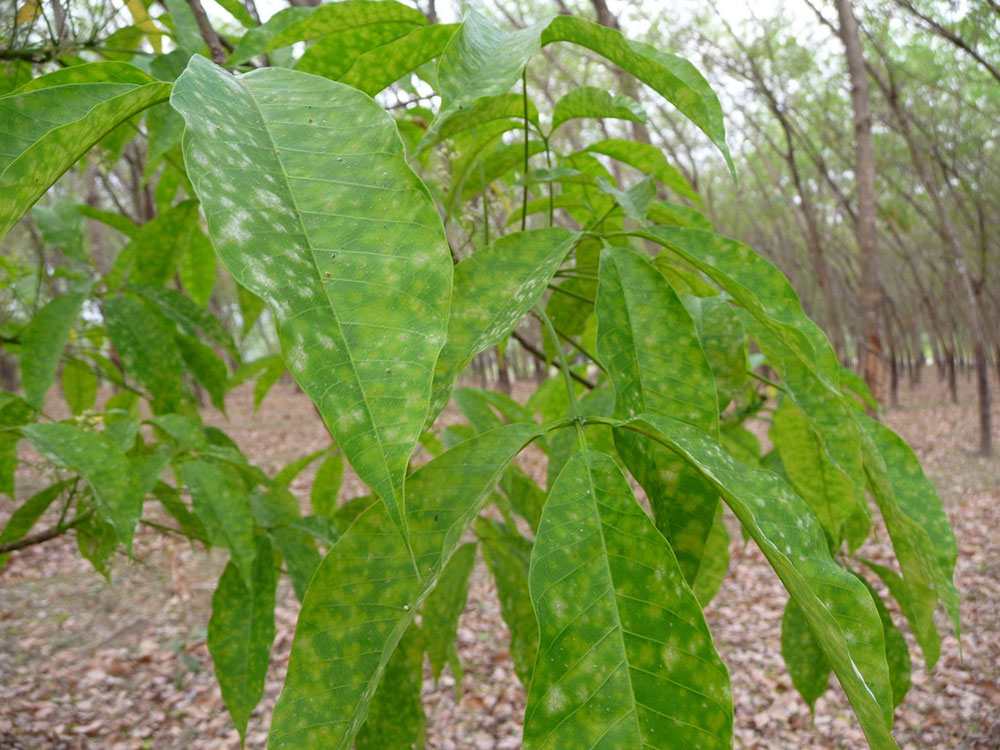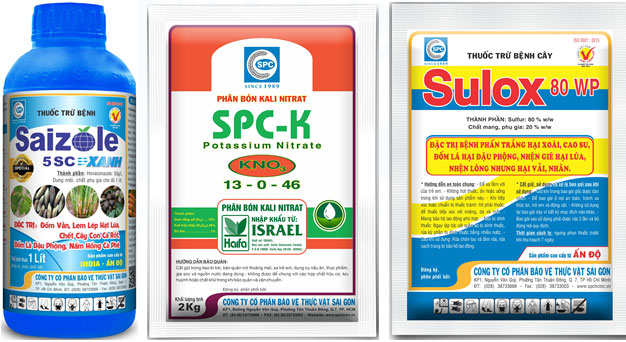|
Rubber Tree Damaging Powdery Mildew
08/06/2021
Ph.D Nguyen Minh Tuyen Rubber is one of the crops for economic value. However, there are many types of pests that significantly affect the yield of rubber. One of the dangerous pests that often appear during the leaf change season is powdery mildew on rubber. The disease has caused the tree to lose leaves many times, causing loss of plant strength, thus slowing down the tapping time and reducing latex production significantly. The disease also slows down the growth rate, or can cause tree death in rubber plantations at the basic stage of construction, breeding and nursery gardens Symptoms: The disease mainly damages the young leaves stage, when the leaves are purple copper colored. The disease causes the leaves to be wrinkled, deformed, the underside of the leaves covered with a layer of white powder, then fall. When the leaves are at the stage of light green, the disease manifests as small pale yellow dots, covered with a thin layer of white powder, then the disease continues to develop, if severe, the leaves will fall. In later stages, diseased leaves do not fall off, but leave patchy yellow lesions, with various shapes.
Causative agent and growing conditions: Powdery mildew is caused by the fungus Oidium hevea. The disease affects rubber trees of all ages, from nurseries, basic construction gardens, to gardens that are being exploited. The disease often causes severe damage during the period when rubber trees start to produce new leaves in early spring every year, especially when there are cold, humid and foggy conditions. A number of preventive measures have been applied with high efficiency: - From the beginning, if possible, choose disease-resistant varieties to plant, or at least not plant infected varieties. - Clean the rubber garden right after the tree drops its leaves (collect leaves and then spread lime or spray product). - Balanced reasonable fertilizing pay attention to increase the amount of potassium fertilizer for plants, should use a combination of foliar fertilizer SPC-K. Visit the rubber garden regularly during the leaf change period, so that appropriate and timely prevention and treatment decisions can be made. - Through the practice of preventing many years of powdery mildew disease, we need to pay attention to preventive spraying at the right time, especially in gardens with high risk of infection or those that have been serious disease in the previous year, easily leaving many diseased remnants on the tree. With the above gardens, it is necessary to spray preventively right away when the leaves are still in the form of buds of the first leaf phase. Spray 2-3 times / wave, each time about 7-10 days. The effective and popular product that farmers often use today is SULOX 80WP (mixed with 300g / 100 liters of water) or SAIZOLE 5SC (mixed with 200-400ml / 100 liters of water, depending on the age of the plants). Spray on young leaves because disease often infects leaves at this stage. On the other hand, at this time the leaves have not yet opened, so they do not shield each other, product is easy to adhere evenly throughout the plant, so the ability in prevention and curativeness is good. When we prevent and protect the first leaf wave effectively, that is the basis for reducing the source of the disease, so the risk of infection for the next leaf wave is reduced. - When spraying, it is necessary to have a spraying device to spray fine mist to the top of the tree to be effective. - Another thing, according to the practical experience of farmers, when the leaves are light green, product should be combined with high-grade foliar fertilizer SPC-K, which will help increase the effectiveness of control. - Mobilize surrounding gardens to prevent diseases to reduce disease sources and avoid spreading each other.
|
To prevent, in addition to plowing and burying weed seeds, collecting weed stalks and stumps left after tilling the land to burn, not letting weeds produce seeds in production fields, etc., the use of chemical products is still a measure. optimal because of its ability to thoroughly kill weeds, reduce labor and take advantage of more time than manual weeding.
Miner has the scientific name Phyllocnistis citrella Staint., family Phyllocnistidae, order Lepidoptera. The miner occurs in many countries in the tropics and subtropics. The main host of the miner is the citrus family - Rutaceae. In addition, the miner also attacks mangosteen and some other plants.
Adult is a small planthopper, with a body 2-3 mm long, the whole body is ash gray, slightly greenish, the wings are opaque with many small brown spots.Eggs are oval, 0.3 mm long, have a pointed end and are attached directly to the leaf surface, leaf axils.
Green bugs specialize in the fruit of citrus groups (oranges, tangerines, lemons, grapefruits, kumquats...), some people call them orange bugs, or orange suckers. Their scientific name is Rhynchocoris poseidon or Rhynchocoris humeralis.
In Vietnam, yellow leaf curl disease is very common on papaya trees, especially the disease is often severe in areas of high and continuous planting, areas with hot and arid climates. The disease has significantly reduced the yield and quality of papaya. Gardens that are infected early when the plants are young may not yield. However, up to now, many gardeners still do not know the cause and how to fix it.
Spider mites are common pests on citrus trees, especially in hot and dry climates that are suitable for spiders to grow and cause severe damage.The group of harmful spiders is usually very small in size, unlike the natural enemy spiders.
This group includes species that are generally very small in size, causing damage by sucking plant sap (on leaves, fruits, branches, stems).
There are many species of mealybugs present on the group of Oranges,Tangerines,Grapefruits and Lemons (Citrus), which can be divided into 2 groups:
+ Group of sticky mealybugs with common varieties such as Lepidosaphes, Aonidiella, Coccus and Saissetia.
+ Group of flower mealybugs with common genera and species such as Pseudococcus, Planococcus and Icerya purchasi.
Dry branches and berries disease often appear to be common damage on coffee gardens during the rainy season. The disease causes death of branchs, dry fruit, severely affects the canopy structure and coffee yield if not paid attention to prevention.
Pink disease commonly causes diseases on rubber plantations in the rainy season, especially on garden from 4-8 years old. This year, rubber has to go through a period of severe drought, weakening the tree, so now in tnshe rainy season it is easy to get infected. Therefore, it is necessary to pay attention to good management to avoid affecting the garden.
In recent years, the area of citrus has been expanded because it is a fruit tree with high economic efficiency. However, in order to sell at a high price, not only in quality but consumers also require the external beauty of the fruit, so pest management on citrus is a matter of great concern to farmers. The hot season is a favorable condition for thrips to develop and cause damage, affecting the commercial value of fruit.
- Headquarters
- SAIGON PLANT PROTECTION JOINT STOCK COMPANY
- RQ 1, Nguyen Van Quy St., Tan Thuan Ward, HCM City
- Tax code: 0300632232
- Tel: (028) 38 733 295 - 38 732 077
- Fax: (028) 38 733 003 - 38 733 391
- Website: www.spchcmc.vn - Email: info@spchcmc.vn
- SAIGON PLANT PROTECTION COMPANY
- SAIGON PLANT PROTECTION JOINT STOCK ENTERPRISE
- Lot C1-C3 Hiep Phuoc Industrial Park, Hiep Phuoc Commune, HCM City
- Tel: (028) 3873 4089 - Fax: (028) 3873 4086
- Affiliated Unit
-
- Quick Links
- Home
- About us
- Career Opportunities













